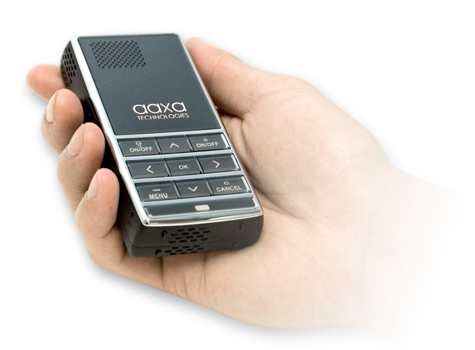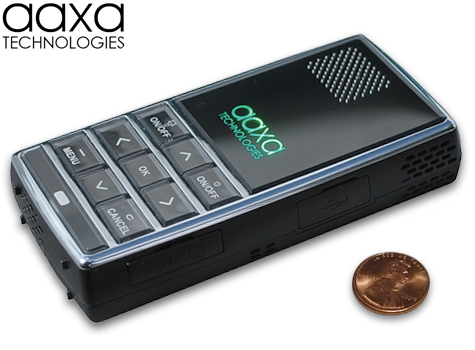
Aaxa’s new L1 laser projector represents a revolution in the handheld projector arena. By combining red, green, and blue lasers with a LCOS (liquid crystal on silicon) imager Aaxa has produced the world’s first handheld laser projector available to the general public.
So What’s So Special about a Laser Projector?
Focus-less operation
Besides the “cool” factor, a laser projector has a variety of uses. Unique to laser projectors is its ability to produce an image without focusing lenses. This means that blurry images are a thing of the past – the image produced by a laser projector is always in focus no matter how far or close the surface is. From a practical standpoint a focus less projector has a variety of uses besides just not having to change the focus every time you move the projector. With a focus-less laser projector curved surfaces such as windshields and aircraft canopies now become viable surfaces for projection. Also rapid changes in projection distance are now possible – meaning a laser projector can be rapidly directed to a variety of projection surfaces – which obviously has a multitude of practical applications.
Improvements over existing handheld projectors
Besides a focus-less optical system, the laser projector has several distinct advantages over LED based hand-held projectors. Because there is no such thing as a white laser, laser projectors rely on individual red, green, and blue lasers which eliminate the color wheel or color filter found in most hand-held projectors. This means better and more vivid colors over traditional hand-held projectors. Furthermore laser optical engines are slightly more efficient than LED based optical engines, and with optical efficiencies frequently less than 15% on most LED projectors even a subtle increase in efficiency means improvements in the size and output of the projection system.
What are the downsides of laser projectors?
The number one issue impairing laser projectors is “speckling”. The “speckling” problem literally means “speckles” in the image. Often this appears as if magic-reflective-fairy-dust was sprinkled on the projected image which distracts the viewer and makes the image hard to view. Speckling occurs when the laser light strikes the projected surface, and the reflected light waves (what you see) interferes with each other – sort of like the wave propagation experiments we all played with in high-school physics. There are a variety of ways electrical, mechanical, and optical methods to combat speckling, some of them more effective than others – but none have succeeded in 100% eliminating the speckle issue.

Another major concern of laser projectors is the pixilation / meshing issue. While more of a problem for beam-steering and DLP laser applications, the issue exists in all laser projection systems. Generally speaking LCOS imagers tend to reduce this problem – but it remains to be seen whether or not Aaxa’s laser projector will exhibit these issues.
Bottom line
Overall Aaxa’s L1 laser projector appears to be the whole shebang and a truly revolutionary departure in the handheld projector arena. It is tiny, makes 20 lumens with high resolution (brighter / higher resolution than any other pico projector its size), has an acceptable battery life, and best of all has an onboard file viewer that can both play videos and show Power Point and PDF files. The only concerns that we have is the high price tag – $599 – almost double its nearest competitor, the 3M Mpro150.
We can’t wait to get our hands on one for testing…
SPECS:
20 Lumens 800×600 Resolution
RGB Laser light source
4.0″ x 2.0″ x 0.75″
145 grams
Onboard media player: JPG, BMP, GIF, ASF, MP4, AVI, PDF, PPT, DOC, XLS
2GB USB drive included
Retail Price: $599
These might be weather proof or waterproof projectors so they can be used where it might be rainy or snowy. If you are planning on showing a film on a summer day, then a portable unit would be your best choice.